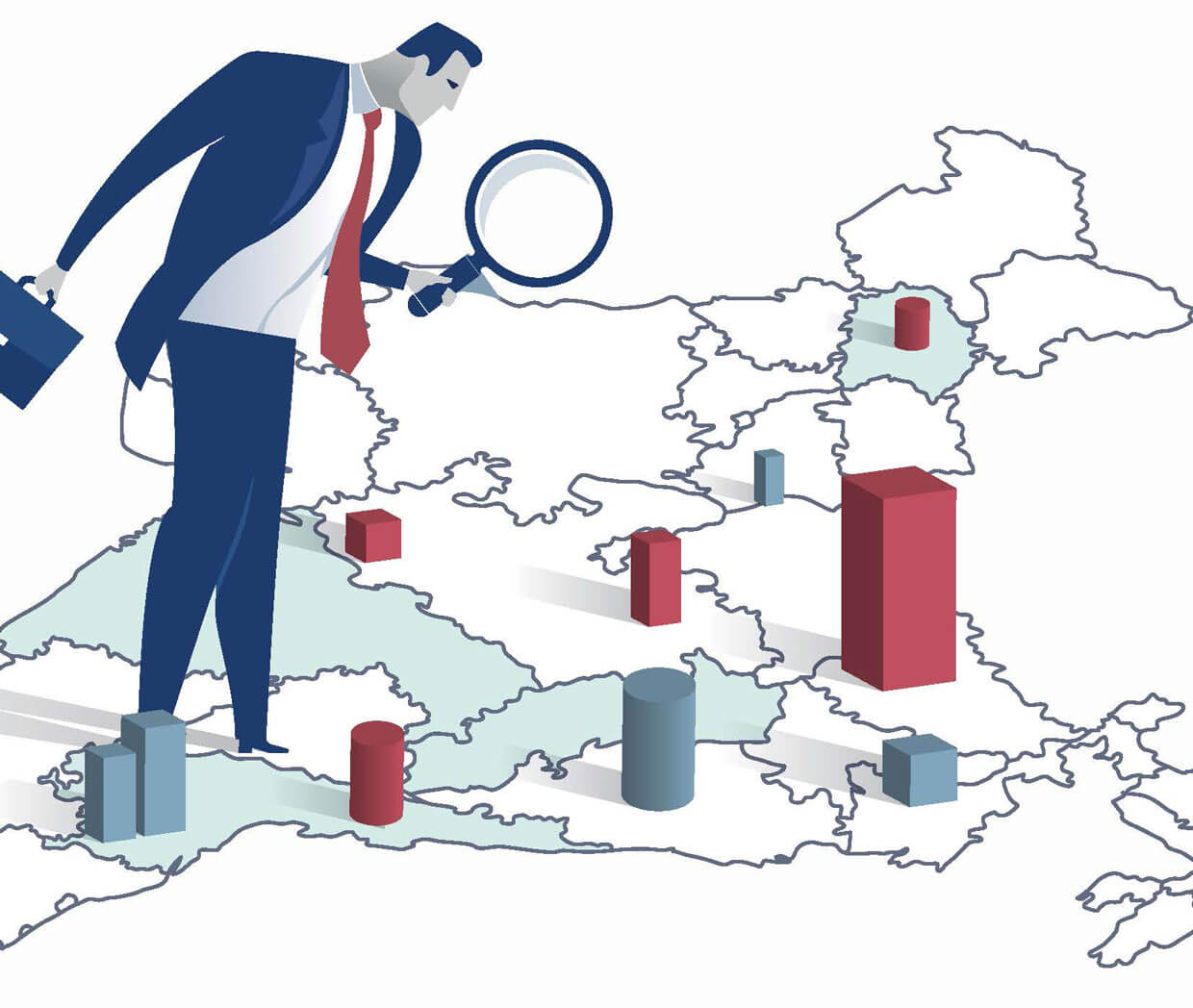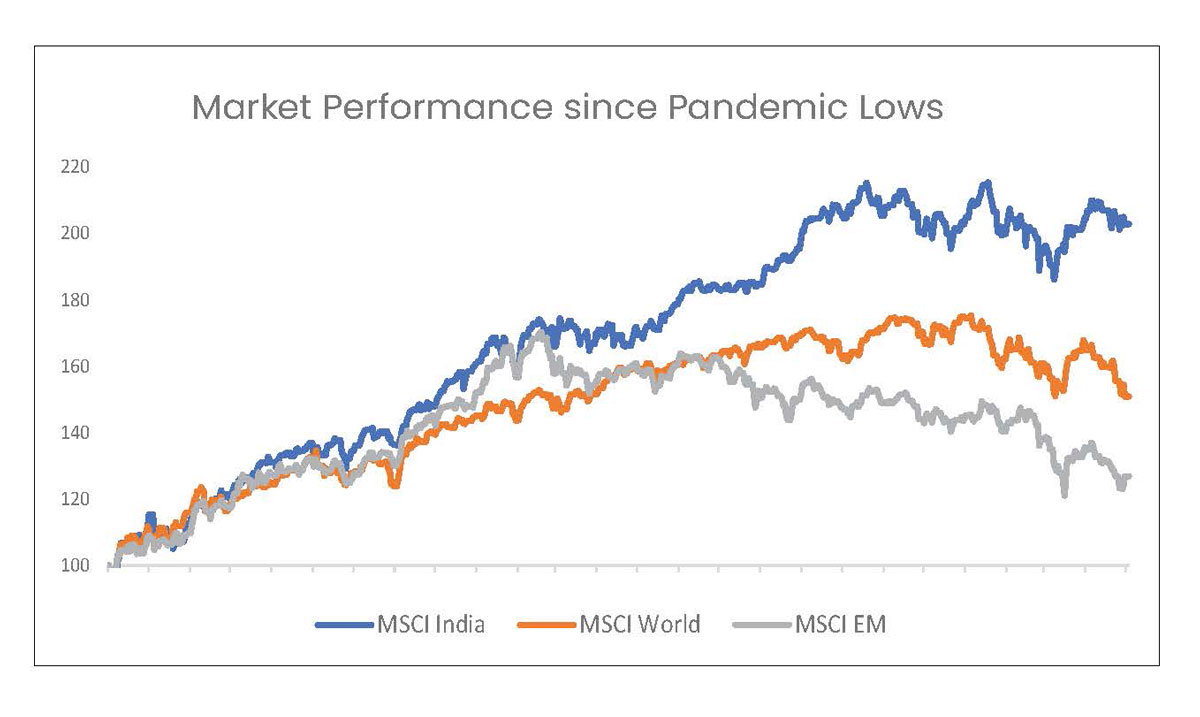
Macro and
Equity Market
Outlook
Equity Market
Outlook
Global Macro & Markets
Persistently high inflation owing to seemingly prolonged
supply chain conundrums and resultant tightening worries have
impacted global equities and bonds alike. US 10Y is up 60bps
MoM and 202bps YTD. US Dollar index has strengthened 4.7% MoM.
LME Metals index had peaked in March and was down 6.6% over
the month. Amid weak global cues and probability of aggressive
rate hike by the US Fed, MSCI World Index fell 8.4% MoM. It
was dragged lower by S&P500 (-8.8%), NIKKEI (-3.5%) and
Euro-50 (-2.6%). NIFTY 50 India (-2.1%) outperformed other
major EMs (Emerging Markets). MSCI EM Index was down 5.7%,
wherein Brazil Bovespa, MOEX Russia & Hang Seng were down 10%,
9.6% and 4.1% respectively.
Domestic Macro & Markets
Indian markets have been buoyant and resilient since the
global markets recovered from the pandemic lows in last two
years. Broader markets outperformed the narrow index over the
month. BSE Midcap index and BSE Smallcap index were up 1.3%
and 1.4% MoM whereas SENSEX was down 2.6%. Among sector
indices, IT, Realty and Metals declined 12%, 4% and 3%
respectively, while utilities gained 18% during the month.
Market breadth declined in April with 42% of BSE 200 stocks
trading above their respective 200-day moving averages. FPIs
sold US$3.6 bn of Indian equities in the secondary market
while DIIs bought US$3.6 bn.

India's high frequency data update:
All-time high GST collections, strength within manufacturing
activity and rising exports bode well for the economy.
Manufacturing PMI:
Manufacturing PMI continued to remain expansionary at 54.7 in
April’22, quite better compared to 54 in March’22. Factories
continued to scale up production at an above-trend pace, with
ongoing increase in sales and input purchasing suggesting that
growth will be sustained in near-term.
GST Collection:
At INR 1.68 Tn (+20% YoY), collections in April’22 have marked
all-time high levels on the back of improved compliance,
enforcement action against tax evaders and pickup in economic
activity.
Core sector production:
Core sector production rose 4.3% YoY in March’22 as against a
YoY rise of 6% in February’22 and a rise of 12.6% same time
last year. On a sequential basis, infra output increased
14.6%.
Industrial Production:
Manufacturing IIP increased 0.8% in Feb’22 vs decline of 3.4%
in Feb last year.
Credit growth:
Credit growth accelerated to 10.1% YoY as of 8-Apr 2022
against YoY growth of 5.3% as observed on 9-Apr 2021.
Aggregate deposit growth also grew 10.1% YoY.
Inflation:
CPI inflation in March’22 shot up to 6.95% from 6.07% on the
back of sequentially higher food (+7.7%) and rural inflation
(+7.7%). WPI inflation increased 140bps to 14.5%.
Trade Deficit:
March’22 trade deficit widened to US$18.7 bn as compared to
US$21.2 bn in February’22. Exports increased 14.5% YoY to
US$40.4 bn while imports increased by 21% YoY to $59 bn.
Balance of Payments:
The current account registered a deficit of US$23 bn (2.7% of
GDP) in 3QFY22, widening from a deficit of US$9.9 bn in 2QFY22
(1.3% of GDP) and a deficit of US$2.2 bn in 3QFY21 (0.3% of
GDP). This was mainly due to a widening of the trade deficit
to US$60.4 bn (2QFY22: US$44.5 bn).
Fertilizer subsidy – revised:
The Cabinet increased the subsidy rate for Phosphatic and
Potassic (P&K) fertilizers under the Nutrient Based Subsidy
(NBS) scheme for the period April-September 2022. Rs 609 bn of
subsidy (for 1HFY23) was approved including support for
indigenous fertilizer (SSP) through freight subsidy and
additional support for indigenous manufacturing and imports of
Di-ammonium phosphate (DAP). Subsidy budgeted for P&K
fertilizers in FY2023 was Rs 420 bn.
Market View
Near term market sentiment is likely to be influenced by the
increased geopolitical risks in the backdrop of ongoing
Russia-Ukraine conflict, higher inflation/ commodity prices,
rate hikes by Global Central Banks and most importantly how
these factors impact the Global/domestic growth possibilities.
Accordingly, we anticipate higher than usual volatility or
market swings in the short term. From a domestic perspective
while direct impact of Russian-Ukraine conflict, through trade
channel may be limited, the indirect impact on Crude prices,
Inflation, rising input or raw material prices needs to be
monitored. Notwithstanding the short-term global risks and
assuming that the geo-political tensions are diffused soon, we
remain optimistic on a reasonable domestic recovery. Key
drivers include - relaxation of most COVID led restrictions
across states which may potentially spur demand, anticipated
revival in investment cycle & domestic manufacturing, etc.
Accordingly, we are attempting to maintain balanced portfolios
through a combination of domestic recovery themes along with
secular businesses. Given the external risks and its potential
impact we believe investing in a staggered manner or
systematic route may help iron out market extremes. Based on
the prevailing valuations diversified funds with allocations
across market cap range may be considered from a medium-term
view. Conservative investors seeking equity exposure with
lower volatility may consider asset allocation strategies like
- Balanced Advantage/Asset Allocator which manage equity
allocations dynamically.
Note:The sectors mentioned are not a
recommendation to buy/sell in the said sectors. The schemes
may or may not have future position in the said sectors. For
complete details on Holdings & Sectors of NIMF schemes, please
visit website mf.nipponindiaim.com;
Past performance may or may not be sustained in future
Past performance may or may not be sustained in future
Chart of the month :
MSCI India has outperformed MSCI World and MSCI EM by 52% and
76% respectively since March 31, 2020 (25 months period).

Common Source:
Bloomberg, Nippon India Mutual Fund Research
Disclaimer:The information herein above is
meant only for general reading purposes and the views being
expressed only constitute opinions and therefore cannot be
considered as guidelines, recommendations or as a professional
guide for the readers. The document has been prepared on the
basis of publicly available information, internally developed
data and other sources believed to be reliable. The sponsors,
the Investment Manager, the Trustee or any of their directors,
employees, Associates or representatives (‘entities & their
Associate”) do not assume any responsibility for, or warrant
the accuracy, completeness, adequacy and reliability of such
information. Recipients of this information are advised to
rely on their own analysis, interpretations & investigations.
Readers are also advised to seek independent professional
advice in order to arrive at an informed investment decision.
Entities & their associates including persons involved in the
preparation or issuance of this material, shall not be liable
in any way for any direct, indirect, special, incidental,
consequential, punitive or exemplary damages, including on
account of lost profits arising from the information contained
in this material. Recipient alone shall be fully responsible
for any decision taken on the basis of this document. Budget
related information contained in this document is for general
purposes only and not a complete disclosure of every material
fact of the Indian Budget. For a detailed study, please refer
to the budget documents available on
http://www.indiabudget.gov.in
